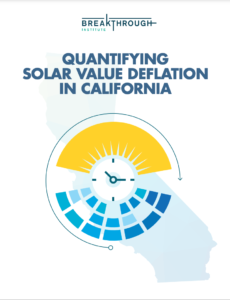Full Title: Quantifying Solar Value Deflation in California
Author(s): Zeke Hausfather
Publisher(s): Breakthough Institute
Publication Date: July 14, 2021
Full Text: Download Resource
Description (excerpt):
Solar photovoltaics (PV) have been a remarkable clean energy success story, with prices falling by a factor of ten and world solar generation increasing 21-fold over the past decade. Solar serves as the best example we have for making clean energy cheap and represents the cheapest source of new electricity generation at the margin in much of the world today. Solar will be one of the largest drivers of decarbonization globally over the next decade and may prove to be the single largest source of new electricity generation over the course of the 21st century.
However, the fact that solar generation is concentrated in a relatively short period of the day means that it is particularly susceptible to a phenomenon known as value deflation. As more solar generation is installed, the average wholesale price of electricity decreases during mid-day hours. This reduces the value of both new and existing solar compared to other electricity sources that are a better match to net load or have a different generation profile.
This report provides a detailed analysis of both historical and projected future value deflation of utility-scale solar in California and is divided into four parts. The first looks at the expansion of solar in California over the past six years, daily and seasonal variation in generation, and how California’s generation mix changes with different levels of solar generation. The second part quantifies how the value of solar has changed in California, both across different hours and seasons of the year and over multiple years. The third part develops a statistical model to evaluate future seasonal and annual value deflation as the percent of solar generation increases. Finally, the fourth part looks at how subsidized and unsubsidized solar costs and values might change through 2045 in a world where California meets its SB100 goals and explores the role of complementary technologies in mitigating value deflation.
